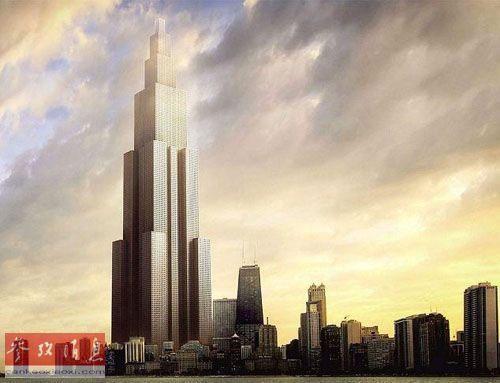

As the world's second largest economy, China is not just getting stronger, but it's also growing taller, with the volume and height of skyscrapers in China growing ever upward. In 1990 there were 5 buildings taller than 200 meters across the country; but by the end of last year, that number exceeded 250.
By today's definition, a skyscraper is any building with a structural height of 500 feet or more. China has adopted high-rises as its preferred building style due to the rapid urbanization process. The blistering pace of construction is seen around the world as a sign of how the economic center of gravity has shifted east with China, getting a new skyscraper every five days, according to research.
 |
|
As the world's second largest economy, China is not just getting stronger, butit's also growing taller, with the volume and height of skyscrapers in China growing ever upward. [Photo / Cankaoxiaoxi] |
"Dizzying construction heights are not unique to places like Beijing, Shanghai or Guangzhou these high towers are popping up everywhere, like mushrooms after the rain. And by 2016 China will have approximately 800 skyscrapers - four times the current number in the US. But do these high-rises really serve the needs of the country, as more and more people move to the city or they are just a symbol of wealth -- flashy concrete monsters, that block urban skylines? The appetite in China for high-rises in the past five years and the next five, is bigger than has ever been seen before in the history of construction. And, people have mixed opinions on it." Guan Yang said.
"We are surrounded by these high rises everywhere we go to, I feel quite depressed as there isn't enough fresh air." Yang Ping, Shenyagn resident said.
"These buildings can't go as high as they want. There should be restrictions when they start to block the light for others' living near by." Zhao Zihua, Shenyang resident.
Once these high-reaching skyscrapers are built, we have issues of designing sustainable urban environments to deal with. If this could be dealt with before hand, it would make a big difference.
"A lot of skyscrapers have experienced "time out" periods when the finance fell short and there was a lack of proper project planning in advance. So the assessment on a skyscraper project needs to more thorough. We should be more realistic on the height by considering who will move into them and why." Huo Ke, Head of Architecture Dept, NE University said.
Another fact about the country's high-rises is that some of them did not rise straight from the ground, but sprang up just to replace existing ones.
The reason for such a phenomenon is that the country's development during the past two decades was too fast; many projects that were once believed to be economical and practical can no longer match the growing urban demand. Huo Ke said.
High-rises may be symbols of the country's growth and progress, but perhaps there is always time to slow down and to weigh the pros and cons.
 Models at Ford pavilion at Chengdu Motor Show
Models at Ford pavilion at Chengdu Motor Show
 Brilliant future expected for Chinese cinema: interview
Brilliant future expected for Chinese cinema: interview
 Chang'an launches Eado XT at Chengdu Motor Show
Chang'an launches Eado XT at Chengdu Motor Show
 Hainan Airlines makes maiden flight to Chicago
Hainan Airlines makes maiden flight to Chicago
 Highlights of 2013 Chengdu Motor Show
Highlights of 2013 Chengdu Motor Show
 New Mercedes E-Class China debut at Chengdu Motor Show
New Mercedes E-Class China debut at Chengdu Motor Show
 'Jurassic Park 3D' remains atop Chinese box office
'Jurassic Park 3D' remains atop Chinese box office
 Beauty reveals secrets of fashion consultant
Beauty reveals secrets of fashion consultant